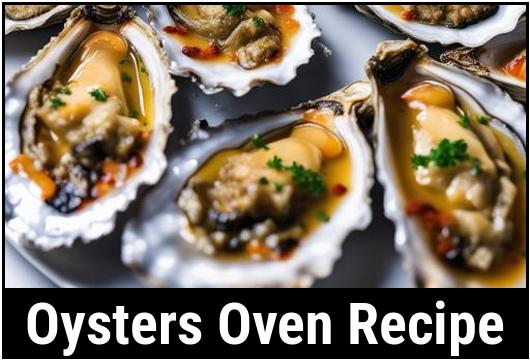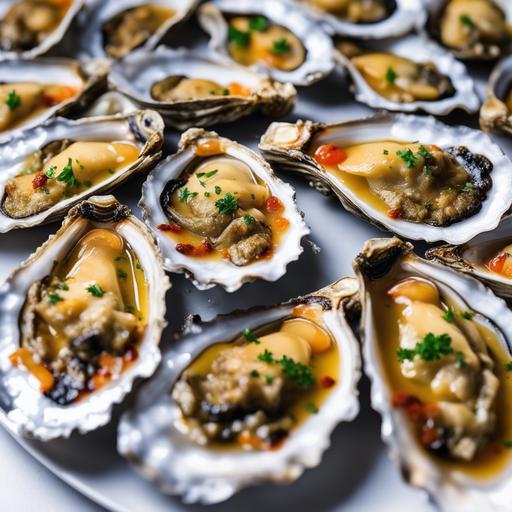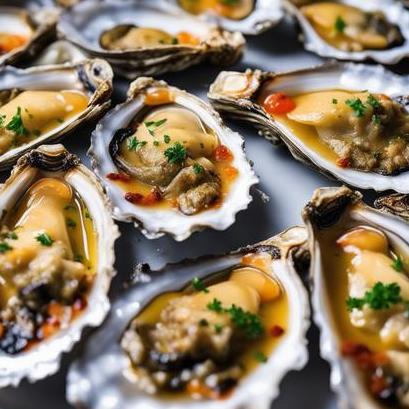
Oysters Oven Recipe: A Comprehensive Guide
Oysters are a popular delicacy all over the world. They are usually eaten raw or steamed, but there is another way to enjoy this delicacy – by cooking them in an oven. Oysters oven recipe is an easy and quick recipe that you can make at home without much expertise. In this article, we will guide you through the process of selecting, cleaning, preparing, cooking, and serving oysters oven recipe.
Food Science of Oysters
Oysters may taste delicious, but they are also packed with essential nutrients. Oysters are high in protein, zinc, iron, and omega-3 fatty acids, making them a highly nutritious food. They are also low in calories and fat, which makes them an ideal food for those who are trying to watch their weight. The high levels of zinc in oysters can also boost the immune system, which makes them a great food to eat during flu season.
Culinary Details
Oysters oven recipe is an amazing way to enjoy oysters. The oven method roasts and lightly steams the oysters, bringing out their natural flavors and aroma. When cooked in the oven, oysters become tender and succulent, and the flavor intensifies. The cooking process helps to get rid of any residual sand or debris that may still be inside the oysters.
Selecting the Oysters

When selecting oysters for oven cooking, ensure that they are fresh and healthy. Make sure that the shells are tightly closed and feel heavy for their size. If you tap the oysters together, they should make a sound. If the oysters are open, avoid buying them. The shell should have a smooth texture, with no cracks or chips that could indicate bacterial infection.
Cleaning the Oysters
Before cooking the oysters, it is important to clean them thoroughly. Start by scrubbing the oysters with a brush under cold running water to remove any dirt or debris on the shells. After cleaning the oysters, place them in a bowl of cold water with a tablespoon of coarse salt for at least half an hour. This saltwater solution will help to remove any remaining grit or sand in the oysters.
Preparing the Oysters
After the oysters have soaked in saltwater, remove them from the solution and rinse them under cold running water. Use a towel to dry the shells and then place them on a baking tray with the flat bottom of the shells facing upwards. The cupped side of the shell should be facing down to hold the oyster in place.
Tips for Cooking Oysters Oven Recipe
-
Preheat your oven to 220°C (425°F). Do not cook the oysters at a lower temperature as it will take longer and make the oysters chewy.
-
Do not overcook the oysters as they will become rubbery and tough.
-
Once you have placed the oysters in the oven, check them after six minutes to make sure they are not overcooking.
-
Use a knife to loosen the oyster from the shell once it has been cooked, and then serve them with your favourite sauce or garnish.
Variations of the Recipe

There are several variations of the oysters oven recipe that you can try. You can add a few drops of lemon juice to the oysters before cooking to give them a citrusy flavor. Another way to add flavor is to sprinkle chopped herbs or spices over the oysters before cooking. You could also try adding garlic, butter, or Parmesan cheese to the oysters before cooking. You can even wrap the oysters with bacon before cooking to give them a smoky flavor.
Doneness Checks for Oven Baked Oysters
It’s important to check the doneness of oysters before serving them. When cooked, the oysters should be plump and look firm, but not rubbery. They should be opaque and not translucent. If you can see any parts that are still translucent, they are not cooked yet. A properly cooked oyster will also have a slightly firm texture.
Oysters Oven Recipe
Here is a simple and easy oysters oven recipe that you can try:
Ingredients
-
12 to 24 fresh oysters
-
Salt
-
Pepper
-
Lemon wedges
-
Tabasco sauce
-
Parsley leaves
Instructions
-
Rinse the oysters under running water and scrub them to remove any dirt or debris.
-
Soak the oysters in a bowl of cold water with a tablespoon of coarse salt for at least thirty minutes.
-
Preheat the oven to 220°C (425°F).
-
Drain the oysters and pat them dry with a towel.
-
Place the oysters on a baking tray with the flat side upwards and the cupped side downwards.
-
Sprinkle salt and pepper on each oyster to taste.
-
Bake the oysters for six to eight minutes, or until the edges are crispy and the meat is firm.
-
Using a knife, separate the oyster from the shell, then discard the flat shell and arrange them on a platter.
-
Drizzle some lemon juice, Tabasco sauce, and garnish with parsley leaves.
-
Serve immediately.
Overcook and Undercook of Oven Baked Oysters
Overcooked oysters will taste tough and rubbery, while undercooked oysters will not have developed the desired flavor. Therefore, make sure to check the oysters for their doneness after cooking for about six minutes. If the oysters are not yet flaky and have not turned opaque in color, you should return them to the oven and bake for another minute. Always avoid overcooking your oven baked oysters, as they will end up chewy.
Conclusion
Oysters oven recipe is a simple and delicious way to enjoy this highly nutritious seafood. With proper selection, cleaning, preparation, and cooking, you can create a wonderful dish that your family and friends will remember for a long time. The recipe variations offer you an opportunity to experiment with your unique flavors and creativity. Try the recipe, and you will be surprised at how easy and fast it is to make tasty oven roasted oysters.
Sources
FAQS On Oysters Oven Recipe
What Ingredients Do I Need To Make Oven-baked Oysters?
To make oven-baked oysters, you will need the following ingredients:
- Fresh oysters
- Melted butter
- Lemon juice
- Garlic cloves (minced)
- Breadcrumbs (preferably panko)
- Parmesan cheese (grated)
- Parsley (chopped)
- Salt and pepper to taste
What Is The Recommended Method For Shucking Oysters?
Shucking oysters can be a bit challenging if you’re not familiar with the process. First, place the oyster flat-side up and use a sturdy oyster knife to insert between the shells. Apply gentle pressure and wiggle the knife back and forth until you locate the hinge. Once you’ve found the hinge, twist the knife to pop it open. Carefully run the knife along the top shell to detach the muscle, then flip the oyster to remove any debris. Be cautious to avoid any shell fragments falling into the oyster.
How Long Should I Bake The Oysters In The Oven?
Preheat your oven to 400°F (200°C). Place the shucked oysters on a baking sheet or in a shallow oven-safe dish. Bake the oysters for approximately 10-12 minutes, or until the edges curl slightly and the butter starts to bubble. Keep an eye on them to prevent overcooking, as overcooked oysters can become rubbery and lose their delicate texture.
Can I Customize The Oyster Topping To My Preference?
Absolutely! While the classic combination of melted butter, garlic, breadcrumbs, Parmesan cheese, and parsley is a crowd-pleaser, you can certainly experiment with additional flavors to suit your taste. Incorporating spices like paprika, cayenne pepper, or even added herbs like thyme or rosemary can provide a unique twist to the dish. Feel free to get creative with the topping to enhance your oven-baked oysters.
Are There Any Precautions To Follow When Consuming Raw Oysters?
Yes, it is essential to be cautious when consuming raw or undercooked oysters due to potential health risks. Oysters can sometimes harbor bacteria, including Vibrio vulnificus, which can cause illness if ingested. To minimize the risk, ensure you purchase oysters from reputable sources and consume them fresh. If you have health concerns, it is advisable to cook oysters thoroughly to eliminate any potential hazards associated with raw consumption.



